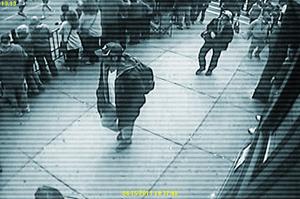Five Days in April: TV’s Captivating Boston Bombing Drama
Back in 1963, when President Kennedy was shot by sniper fire while being driven in a motorcade in Dallas, network television did something unprecedented. It wiped out all regular programming for the next several days, following the unexpected breaking news story wherever it led. Eventually, that period came to be known, by historians, as “Four Days in November.”
Fifty years later, from the time this past Monday when bombers ruthlessly disrupted the Boston Marathon to Friday night, when the surviving second bombing suspect was located and safely apprehended, television spun out another (literally) captivating ongoing narrative of its own.
Call it — because it fits perfectly — “Five Days in April.”
In terms of importance and historical weight, there is, of course, no comparison between the felling of a U.S. president and the disruption of a local sporting event. But in other respects, comparing the two cold-blooded acts of murder, set half a century apart in the history of both America and television, reveals a lot about how things have changed.
And how, in other respects, they haven’t.
In both 1963 in Dallas and 2013 in Boston, the routes for these very public events were published and diagrammed in advance: the motorcade route for JFK, and the Marathon route through the streets of Boston. In both cases, the perpetrators could pick their spots and wait.
Both breaking-news tragedies involved unexpected, horrifying acts of violence, followed by a frenzied and far-flung manhunt. In both instances, the aftermath included the claiming of other lives, both of officers who just happened to cross paths with the alleged perpetrators, and of the alleged killers themselves.
Both stories had a nation huddled around its TV sets for days. Both had an emotional resonance that, to anyone who watched, will never be forgotten. There also, though, were very significant differences between then and now.
• 1963: Though there were TV cameras at several points along the JFK parade route, not one was in place at Dealey Plaza that dark day in Dallas. Only one man, Abraham Zapruder, filmed the assassination, with a newly acquired 8mm camera he was trying out. Without it, and without police-dispatch recordings from the open mike of one motorcycle cop, there would be no as-it-happened complete record of the event. (And even then, Zapruder’s view of the first shot was obscured by a street sign.)
 • 2013: Because cameras were already in place at and near the finish line of the Boston marathon, footage of the two explosions was available immediately, and shown exhaustively — footage showing people selflessly running towards the source of the blasts, to aid victims. And in the days that followed, authorities tapped security cameras along the route, and even asked everyone at the event to upload images and videos from their phones and cameras. Once pictures of the two suspects were released to the media, everything moved into high gear, careering from chase to shootout to city-wide lockdown to eventual capture.
• 2013: Because cameras were already in place at and near the finish line of the Boston marathon, footage of the two explosions was available immediately, and shown exhaustively — footage showing people selflessly running towards the source of the blasts, to aid victims. And in the days that followed, authorities tapped security cameras along the route, and even asked everyone at the event to upload images and videos from their phones and cameras. Once pictures of the two suspects were released to the media, everything moved into high gear, careering from chase to shootout to city-wide lockdown to eventual capture.
• 1963: There was no cable, much less 24-hour cable news networks, yet TV acted just like a broadcast version of CNN 50 years ago. And while the JFK assassination was not shown on TV then, the murder of alleged assassin Lee Harvey Oswald, while being transferred into federal custody, was. On some networks, the murder was even televised live — one of the many unbelievably shocking, stunning events from those four days of constant news coverage.
• 2013: The manhunt portions of the story, in the final day, were told, for the most part, out of camera range, but were no less dramatic for it. Accounts of the first suspect’s death, and the shootout with police, were reported verbally, with no supporting footage or images. When the second suspect was located hiding in a backyard in Watertown, on or under a dry-docked boat, we were shown still images from Google and Bing, but TV cameras weren’t close enough to film live. Shots were heard, but not seen, and even the moment of capture was described, not shown. Even so, it was a riveting TV event, unfurling in prime time on Friday night as a nation watched.
• 1963: Out of the four days of coverage, CBS anchor Walter Cronkite cemented his reputation as a trusted newsman — and his near-loss of composure when announcing Kennedy’s death remains an iconic moment in TV history.
• 2013: CNN and Fox News both blew it (CNN most egregiously) by misreporting news of arrests at midweek, but clear, trustworthy voices did emerge throughout the week of Boston coverage. Among the very best: Pete Williams of MSNBC, who emerged as the smartest and best-informed of the bunch. (Oh, and kudos to Jon Stewart of Comedy Central’s The Daily Show as well, for enumerating and ridiculing CNN’s string of mistakes.)
• 1963: “Four Days in November” concludes emotionally, when young John-John Kennedy salutes his father’s coffin as it passes by in the presidential funeral cortege.
• 2013: “Five Days in April” concludes emotionally, when residents of Watertown line the streets to salute, and applaud, police and other authorities as they leave the area after capturing the surviving suspect. It was an impromptu parade of sorts, obviously emotional for the participants as well as the onlookers.
And that applied to the onlookers watching on TV, as well.